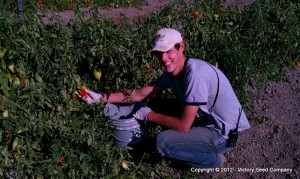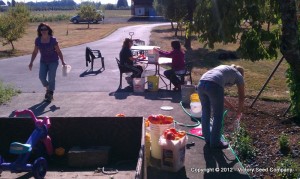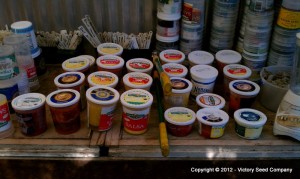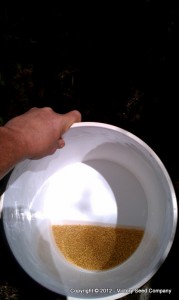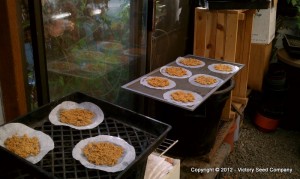It has again been some time since my last blog post. I often think about cool and interesting things to tell you about but it is usually when I am working out in the field or up to my elbows in fermenting tomato seed sludge. I can’t wait until we there is a direct brain to blog interface available. Until then, I suppose this will have to do.
Let’s see . . . what’s new?!?! Well, once our summer finally arrived (about July 5th  ), it ended up being one of the driest ones in years. Our installation of drip irrigation really paid off. With minimal effort, we kept everything in the field watered as needed and things have done very well. Although it was dry, the temperatures were very mild. This made it pleasant to work out in but has affected maturation on things like peppers, eggplants and tomatoes. If the weather holds out for a few more weeks, we should be fine but this is always the “nail biting” time of the year when an early frost can end up . . . well you get the idea. I don’t want to jinx it.
), it ended up being one of the driest ones in years. Our installation of drip irrigation really paid off. With minimal effort, we kept everything in the field watered as needed and things have done very well. Although it was dry, the temperatures were very mild. This made it pleasant to work out in but has affected maturation on things like peppers, eggplants and tomatoes. If the weather holds out for a few more weeks, we should be fine but this is always the “nail biting” time of the year when an early frost can end up . . . well you get the idea. I don’t want to jinx it. 
We have been busy harvesting peas, beans, cardoon, tomatoes, and ground cherries. If all goes well and germination tests prove positive, we should have a lot of those popular and currently out-of-stock varieties available once again for the 2013 gardening season.
And speaking of ground cherries . . . I spent several hours yesterday and today processing five gallon buckets of ‘New Hanover‘ and ‘Cossack Pineapple‘ ground cherries that Melanie picked and de-husked (thank you Melanie). While fresh in my mind, I thought that I would share some seed saving tips. Basically I use a process very similar to the tomato process outlined by clicking here, with a couple of differences.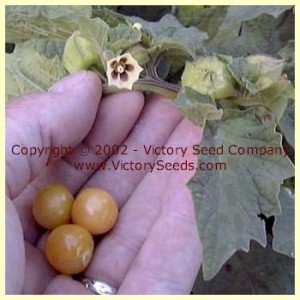
Start with the ripest fruit (they drop from the plant when ready) that are a nice golden color. Then, as mentioned, they are removed from the husk. This is a tedious, manual process so if you have any tips, I would love to hear them. Then, instead of cutting and squeezing, I cheat and use an old Good-Will acquired, cheap, blender and using the pulse function, break the fruit up into a slurry. Don’t go overboard here or you might start damaging seeds. I pour the fruit-smoothie looking (and smelling) contents into a five gallon bucket stopping when half full (more on why in a sec), cover so fruit flies don’t find it, and place somewhere warm (I use a greenhouse or the potting shed).
Unlike tomatoes, they do not need to be fermented for several days. Although they can be immediately processed, I usually wait 24 hours. I just have found that it is easier for me. So, I pop the lid off of one of the half-full buckets and using a spray nozzle on the hose, fill the bucket to the brim. Give it a minute or two and the good seeds will settle to the bottom and you can pour off the bits of skin, flesh, juice and immature or hollow seeds. Fill the bucket with water again and repeat. Do this as many times as it takes you to get nice, clean seed.
Some folks pour off through screens or strainers but for me, I prefer to dry them on coffee filters. Again, this is just my preference. The main goal, like any wet seed processing, is to get the seeds cleaned and dried as quickly as possible. By placing small amounts into many coffee filters, I am able to get them in front of a fan in the barn and dried in no time. I also like handling the smaller amounts when getting the big, dried clumps of seed broken up and readied for sale.
Anyway, this is what I did yesterday and today and although you probably won’t be growing out and processing several pounds of ground cherry seeds, you can scale down the process outlined above, using smaller containers for example, and save your own seeds. If not, I know where you can get some . . . and I already did all the hard work for you. 
Both ‘New Hanover‘ and ‘Cossack Pineapple‘ are currently out of stock, but if you are interested in receiving an email when they are ready, click on the links and click the “Put Me On The Waiting List” button.
So until next time, I hope that you enjoy the fall and that your harvests are bountiful. Thank you again for your continued support of our seed variety preservation work! ~Mike
P.S. – If you are unfamiliar with ground cherries, click on the links above. They really are an interesting old garden staple that seemed to fall our of favor sometime in the 20th Century. I am not sure why. They are sweet and tasty, easy to grow, and the reward at harvest time is well worth the effort.
I have added a couple of recipes to the the VintageVeggies.com recipe page . . . look towards the bottom under desserts. If you have any other old family recipes, or even memories and stories, please do share them.
![]() Small batches, all by hand.
Small batches, all by hand.